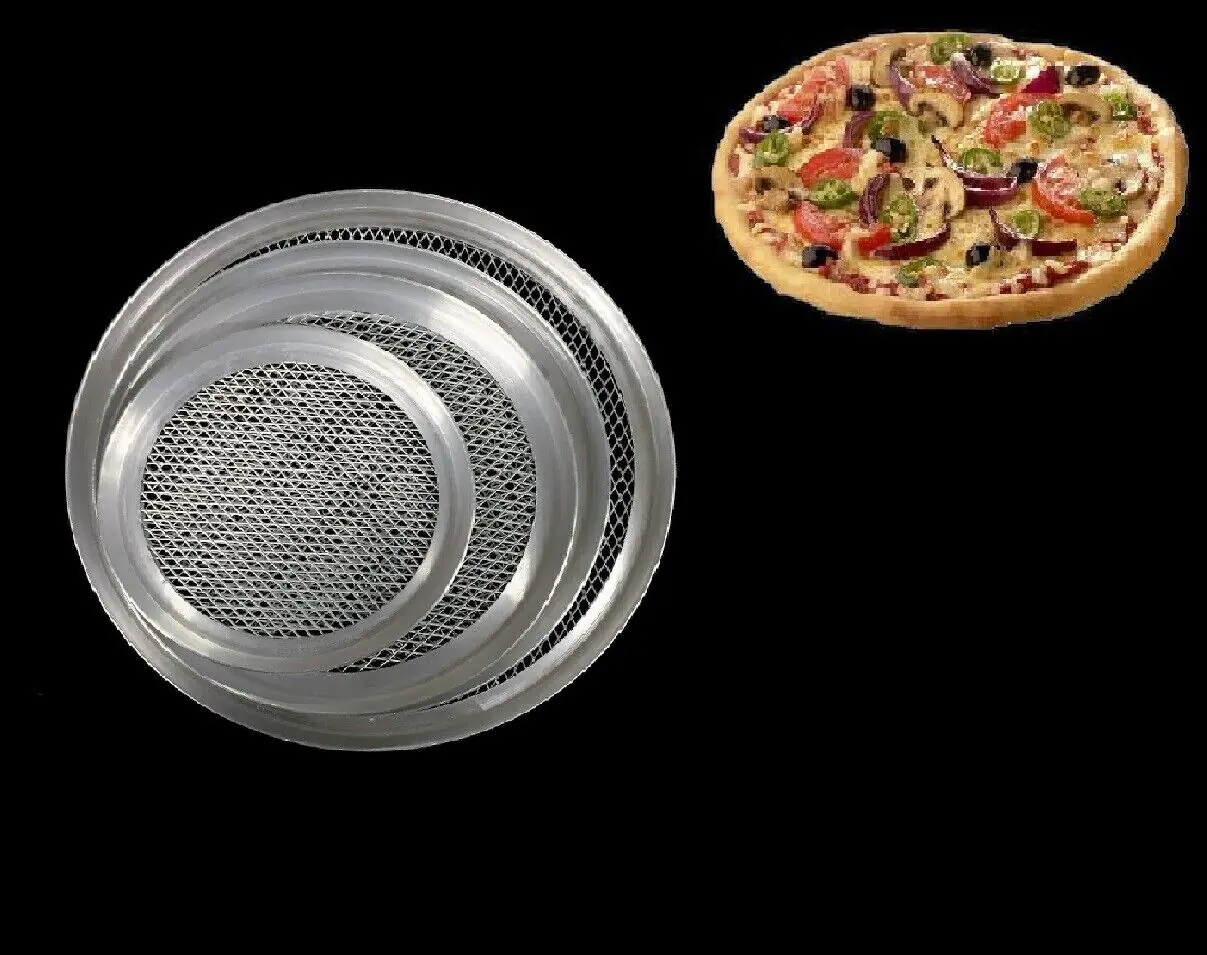A pizza pan makes the crust crispier, while a pizza crisper has holes for a crispier crust. When baking pizza, the type of pan you use can make a big difference in the outcome of your crust.
A pizza pan, which is solid with no holes, allows heat to build up, resulting in a softer, doughier crust. On the other hand, a pizza crisper has holes in the bottom, allowing heat to circulate evenly and resulting in a crispy, crunchy crust.
So, a pizza crisper pan is the way to go if you prefer a thin crust. A pizza pan is the better option if you prefer a thick crust. We will explore the differences between these two types of pans and help you choose the best one for your pizza preferences.

Credit: www.pizzabien.com
The Role Of Pizza Pans In Crust Crispiness
Pizza pans and pizza crispers are crucial in achieving the perfect crust crispiness. While a pizza pan with holes allows air and heat to directly hit the crust for a crispier texture, a solid pizza pan retains heat, resulting in a softer, doughier crust.
Choose the right pan based on your preference for a thin or thick crust.
Discuss The Function Of A Pizza Pan In Baking A Pizza Crust:
A pizza pan is essential in achieving the perfect baking pizza crust. It provides a stable platform for the dough and helps distribute heat evenly, resulting in a crispy and delicious crust. Additionally, a pizza pan helps prevent the toppings from sliding off during baking, ensuring a well-balanced pizza.
Describe The Different Types Of Pizza Pans Available In The Market:
Several types of pizza pans are available in the market, each with advantages and disadvantages. Some common types include:
- Solid Pizza Pan: This pizza pan is made from a solid metal material, such as aluminum or stainless steel. The material is durable and retains heat, resulting in a crispy crust.
- Perforated Pizza Pan: A pizza pan has small holes spread across the surface. These holes allow hot air to circulate underneath the dough, promoting a crispy bottom crust.
- Non-Stick Pizza Pan: As the name suggests, a non-stick pizza pan has a coating that prevents the dough from sticking, making it easier to remove the pizza without any mess.
Explain How A Solid Pizza Pan Affects The Crust Crispiness:
A solid pizza pan, such as aluminum or steel, has excellent heat retention properties. When the pizza dough is placed on a solid pan, the metal absorbs and distributes heat evenly, resulting in a crispy crust.
The solid surface also helps prevent the dough from getting soggy by creating a barrier between the dough and any moisture released from the toppings.
Highlight The Benefits And Limitations Of Using A Solid Pizza Pan:
Benefits of using a solid pizza pan:
- Even heat distribution: Solid pizza pans ensure evenly distributed heat, promoting a consistent bake and crispy crust.
- Durability: Solid pizza pans are typically made from durable materials like aluminum or stainless steel, making them long-lasting and resistant to warping.
- Versatility: Solid pizza pans can be used for various pizzas, including deep-dish or thin-crust, making them a versatile choice for home chefs.
Limitations of using a solid pizza pan:
- Longer baking time: Solid pizza pans retain more heat, resulting in a slightly longer baking time than other pan types.
- Limited airflow: The solid surface of the pan can restrict airflow underneath the dough, which may result in a slightly less crispy crust than perforated pans.
Mention Any Recommended Pizza Pans For Achieving A Crispy Crust:
Recommended pizza pans for achieving a crispy crust:
- Solid pizza pan: Look for high-quality aluminum or stainless steel pans with a smooth, non-reactive surface.
- Perforated pizza pan: Opt for a pan with evenly spaced holes for adequate airflow while baking.
These pans can be found easily in the market and are known for their ability to produce a crispy and delicious crust.
The Role Of Pizza Crispers In Crust Crispiness
A pizza crisper with holes in the bottom allows heat to circulate evenly, resulting in a crispy, crunchy crust. In contrast, a solid pizza pan allows heat to build up, making the crust softer and doughier. Choose the right option based on your crust preference.
Pizza crisps must be considered when achieving the perfect pizza crust. These specially designed pans or trays are essential for creating a crispy crust that is a joy to bite into. Pizza crispers allow hot air to circulate evenly around the pizza, helping to crisp up the dough and create that sought-after crunch.
Whether you prefer a thin, New York-style crust or a thicker, deep-dish style, a pizza crisper can enhance your baking process and take your pizza game to the next level.
How A Pizza Crisper Works To Create A Crispy Crust
A pizza crisper typically features small perforations or holes on its surface. These tiny perforations allow heat to penetrate the dough from all angles, ensuring an even baking process. As the pizza bakes, the hot air circulates through the holes, creating a crispy texture on the bottom of the crust.
This design also helps to prevent soggy or undercooked spots, resulting in a consistently crisp and evenly cooked crust. So, if you’ve been struggling to achieve that perfect crunch, a pizza crisper might answer your prayers.
Types Of Pizza Crispers Available
Several types of pizza crispers are available on the market, each with advantages and disadvantages. Here are three popular options to consider:
- Ceramic Pizza Crisper: This type of crisper is made from ceramic material, which helps to distribute heat evenly. Ceramic crispers absorb excess moisture from the dough, resulting in a crispier crust. They are also oven-safe and can retain heat well, ensuring your pizza stays warm for longer.
- Stainless Steel Pizza Crisper: Stainless steel crispers are durable and resistant to rust, making them a popular choice among pizza enthusiasts. These crispers are known for their excellent heat conductivity, which allows for faster and more even baking. In addition, they are easy to maintain and clean, making them ideal for everyday use.
- Non-Stick Pizza Crisper: As the name suggests, non-stick pizza crispers feature a non-stick coating that prevents the dough from sticking to the surface. This not only makes it easier to remove the pizza from the crisper but also allows for a more even distribution of heat. Non-stick crispers are usually dishwasher-safe, making cleanup a breeze.
Advantages And Disadvantages Of Using A Pizza Crisper
Using a pizza crisper offers several advantages, but it’s important to consider any potential drawbacks. Here’s a quick overview:
Advantages:
- Creates a crispy crust: The main advantage of using a pizza crisper is achieving a crispy crust, adding a satisfying texture to your pizza.
- Even heat distribution: Pizza crispers ensure that heat is evenly distributed, resulting in a more consistent baking process and a well-cooked pizza.
- Versatility: Pizza crispers can be used for baking other foods like cookies or heating frozen snacks, making them a versatile addition to your kitchen.
Disadvantages:
- Limited to certain crust types: Pizza crispers are most effective for thin and medium-thick crusts. If you prefer a deep-dish or stuffed-crust pizza, a crisper may not produce the desired results.
- Extra storage space: Pizza crispers can take up additional storage space in your kitchen, so consider your available space before purchasing.
Recommended Pizza Crispers For Achieving A Crispy Crust
If you’re in search of a pizza crisper to help you achieve that perfect crispy crust, here are a few highly recommended options:
- Chef Pomodoro Pizza Baking Set: This set includes a durable pizza crisper with holes designed for superior heat circulation and an even bake. It also has a pizza wheel and a stainless-steel serving spatula for a complete pizza experience.
- RSVP Endurance Stainless Steel Pizza Pan: Made from high-quality stainless steel, this pizza crisper offers excellent heat conductivity for a quicker baking time and a crispy crust. Its flat surface and rolled edges make sliding the pizza on and off the pan easy.
- GoodCook AirPerfect Insulated Non-Stick Pizza Pan: This non-stick pizza crisper is perfect for individuals looking for a hassle-free baking experience. Its insulated design ensures even heat distribution, and the non-stick coating ensures easy cleanup.
A pizza crisper can be a game-changer in achieving a crispy crust. Consider the different types available, weigh the advantages and disadvantages, and choose a recommended crisper that suits your needs and preferences. With the right tools and techniques, you’ll be well on your way to enjoying delicious, crispy homemade pizza.
Pizza Pan Vs Pizza Crisper: A Comparison
Pizza Pan vs. Pizza Crisper: What’s the difference? A pizza pan is solid with no holes, resulting in a softer, doughier crust, while a pizza crisper has holes in the bottom, allowing for even heat circulation and a crispy, crunchy crust.
Choose the pan that suits your preference for the perfect pizza.
Compare The Effectiveness Of Pizza Pans And Pizza Crispers In Creating A Crispy Crust:
- Pizza Pan:
- Provides a solid surface for the pizza dough to rest on.
- Produces a slightly softer crust compared to a pizza crisper.
- Baking time may be longer due to the slower heat distribution.
- Pizza Crisper:
- Features perforations that allow heat and air to reach the crust directly.
- Creates a crispier crust compared to a pizza pan.
- Baking time is generally shorter due to the enhanced heat circulation.
Discuss The Differences In Crust Texture Achieved With Each Option:
- Pizza Pan:
- Results in a crust with a golden brown color and a soft, chewy texture.
- Offers a more traditional pizza experience.
- A slightly softer crust is perfect for those who prefer it.
- Pizza Crisper:
- Yields a crust that is crisp and crunchy.
- Provides a unique and enjoyable texture.
- It is ideal for individuals who enjoy a crispy crust experience.
Consider Factors Like Baking Time, Heat Distribution, And Crust Consistency:
- Baking time:
- Pizza pan: Longer baking time due to slower heat distribution.
- Pizza crisper: Shorter baking time due to enhanced heat circulation.
- Heat distribution:
- Pizza pan: Slower heat distribution but creates a more even cook.
- Pizza crisper: Allows for faster, direct heat distribution for a quick, crispy crust.
- Crust consistency:
- Pizza pan: Soft and chewy crust.
- Pizza crisper: Crisp and crunchy crust.
Evaluate Which Option Is More Suitable For Different Preferences And Baking Styles:
- Pizza pan:
- Recommended for those who enjoy a softer and more chewy crust.
- It is ideal for traditional pizza and baking styles requiring longer cooking times.
- Pizza crisper:
- Suitable for individuals who prefer a crispy and crunchy crust.
- Perfect for thin-crust pizzas and baking styles that require shorter cooking times.
Both pizza pans and crispers offer unique benefits in creating delicious pizzas with different crust textures. Choosing between the two depends on personal preferences, baking styles, and the desired crust consistency. Whether you opt for a softer, chewy crust with a pizza pan or a crispy, crunchy crust with a pizza crisper, both options will enhance your pizza baking experience.
Frequently Asked Questions On Pizza Pan Vs Pizza Crisper
Yes, a pizza pan can make pizza crispier. A perforated pizza pan with holes allows air and heat to hit the crust, producing a crispier crust.
A pizza stone is better for a crispier crust, while a pizza pan is better for a softer, doughier crust.
Yes, a pizza pan makes a difference. A pan with holes makes the crust crispier, while a solid pan produces a softer crust.
Yes, you can use a pizza stone with a pizza pan.
Conclusion
Choosing between a pizza pan and a pizza crisper ultimately depends on your preference for crust consistency. A pizza pan with no holes allows heat to build up, resulting in a softer and doughier crust.
On the other hand, a pizza crisper with holes in the bottom allows heat to circulate evenly, resulting in a crispy and crunchy crust. A pizza crisper pan is the way to go if you prefer a thin crust. The holes in the crisper pan promote a crispy texture that perfectly complements a thin crust.
However, a solid pizza pan is better if you prefer a thick crust. The lack of holes in the pan allows the crust to rise and create a softer, doughier texture. Ultimately, both options have their merits and can result in delicious pizzas.
It’s important to consider your desired crust texture when making your choice. Whether you go for a pizza pan or a pizza crisper, you can create mouthwatering pizzas that satisfy your cravings.

As the author of the “Ultimate Pizza Guide: Recipes, Tips & Secrets Revealed,” I’m dedicated to sharing my love for pizza and empowering others to create delicious homemade pizzas with ease. Join me on a journey to uncover the secrets to perfecting your pizza game!



